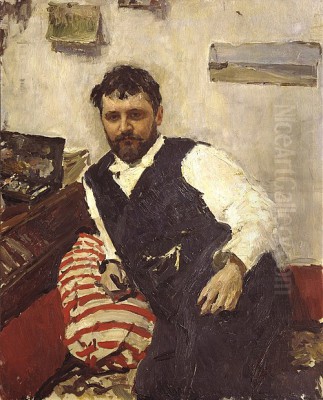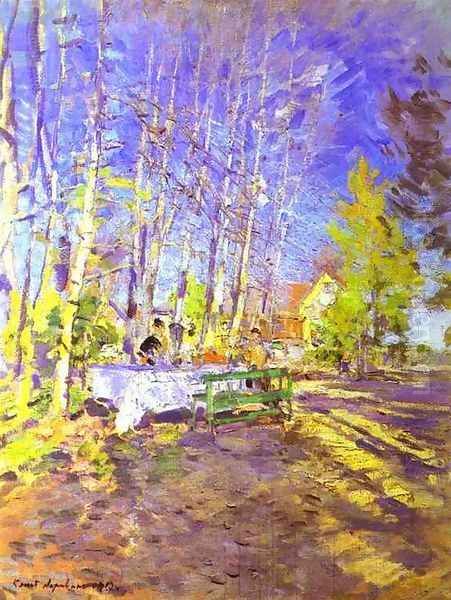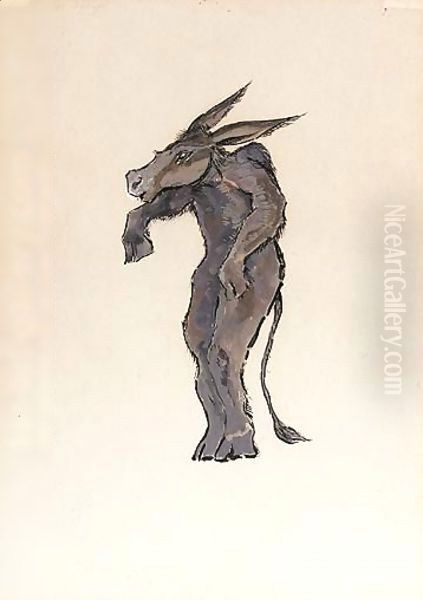Konstantin Korovin: The Russian Impressionist of Light and Color

Konstantin Alexeievich Korovin (1861-1939) stands as a monumental figure in Russian art, widely regarded as a pioneer of Russian Impressionism. Born into a merchant family in Moscow, his artistic inclination was nurtured from an early age, inheriting a passion for the arts from his father, Mikhail Alexandrovich Korovin, a university graduate more interested in art and music than commerce. This familial background provided a fertile ground for his burgeoning talent.
Early Life and Education
Korovin's formal artistic education began at the Moscow School of Painting, Sculpture and Architecture at the tender age of 14. Although he initially enrolled in architecture, his true calling quickly emerged, leading him to switch to painting. During his time at the school, he was fortunate to study under prominent figures of the time. Among his influential mentors were Vasily Perov, Alexei Savrasov, and Vasily Polenov. Perov’s guidance was crucial in shaping Korovin’s distinctive approach to color and light. Savrasov, another significant mentor, encouraged stylistic experimentation and demonstrated remarkable flexibility in his teaching methods, which profoundly impacted Korovin's artistic development.
Seeking broader artistic horizons, Korovin briefly attended the Saint Petersburg Academy of Arts from 1881 to 1882. However, he found the teaching methods there rigid and ultimately returned to Moscow, where he felt more aligned with the artistic environment. It was at the Moscow School that he forged lasting friendships with fellow students who would also become celebrated artists, including Valentin Serov and Isaac Levitan. These friendships remained vital throughout his life, fostering mutual support and artistic exchange.
Artistic Style and Evolution
Korovin's artistic style is deeply rooted in Impressionism, heavily influenced by French masters such as Claude Monet. He is often credited as one of the founders of "Russian Impressionism," a movement that blended the spontaneity and vibrant palette of French Impressionism with a distinctly Russian sensibility. His works are characterized by their brilliant use of color, sensitivity to light, and delicate brushwork, capturing the fleeting beauty of nature and human subjects.

He was particularly adept at portraying the changing light of different times of day and seasons. Whether depicting the bright sunlight of a spring day or the soft glow of evening lights, Korovin's use of color and brushstrokes brought these moments vividly to life. His art embodies a unique blend of traditional Russian elements and Western modern art techniques, including elements of Art Nouveau and Decorative Arts, giving his work a distinctive cross-cultural appeal.
Notable Works
Korovin's diverse body of work includes landscapes, portraits, still lifes, and theatrical designs. Several pieces stand out as representative of his artistic vision and mastery. One such work is Spring (1917), a captivating depiction of the Russian spring landscape, featuring pine trees, houses, and figures seated at a table. The painting's rich color palette and emotional depth exemplify his keen observation of nature and life.
Gurzuf, painted during his Crimean period, is a prime example of his landscape painting, radiating warmth and tranquility. His early Impressionist piece, Portrait of a Chorus Girl (1883), showcases his ability to capture the essence of theatrical scenes. Paris Cafe (1895) vividly portrays the atmosphere of Parisian nightlife, employing short, precise brushstrokes to convey the play of light.
Beyond easel painting, Korovin was a highly regarded stage designer and theatrical decorator. He created sets for numerous famous operas, including Aida, Don Pasquale, and Carmen. These designs, blending Impressionist and Art Nouveau styles, demonstrate his profound understanding of theatrical art and cemented his influence in the art world.
Collaboration and Contemporaries
Korovin's relationships with his contemporaries were marked by collaboration and mutual artistic influence rather than competition. He was an active member of the Russian artistic community and a key figure in various art associations. He was a member of the Union of Russian Artists, which brought together many young Russian Impressionists, including Abram Arkhipov, Serge Ivanov, and Alexandr Stepanov.
His collaboration with Valentin Serov extended beyond their student years at the Moscow School of Painting, Sculpture and Architecture. They maintained a close friendship and participated together in several art exhibitions and society activities, influencing each other's artistic journeys. Similarly, his friendship with Isaac Levitan, another fellow student, fostered a shared pursuit of artistic truth and mutual inspiration. Korovin also acknowledged the impact of Vasily Polenov on his artistic development during his time at the Moscow School.

While direct, documented collaborations with specific French painters are less clear, Korovin's deep admiration for and influence by French Impressionists like Monet and Cezanne is undeniable. His extensive stays in Paris allowed him to immerse himself in the vibrant Parisian art scene, undoubtedly leading to exchanges and interactions with numerous French artists of his time, even if specific collaborative projects are not widely recorded.
Significant Exhibitions and Activities
Korovin's participation in major exhibitions and artistic events significantly boosted his reputation and promoted the Impressionist style in Russia and internationally. A pivotal moment was his work for the All-Russia Exhibition in Nizhny Novgorod in 1896, where he designed the Northern Railway pavilion and created ten large canvases depicting scenes of the North and Russian life. These works received critical acclaim for their artistic merit and brought him international recognition.
Even more significant was his role as the artistic supervisor for the Russian section at the 1900 Paris World Exhibition. He designed the central area of the Russian Imperial Pavilion and created decorative panels, earning two gold medals and the Order of the Legion of Honour. This achievement solidified his standing on the international stage.
Korovin was also a member of important art groups such as Mir Iskustva (World of Art) and participated in exhibitions organized by various artist associations, including the Peredvizhniky (Itinerants) and Soyuz 36 (Union of Artists). These exhibitions showcased not only his paintings but also his interests in stage design and architectural decoration.
His dedication to art education was also noteworthy. As a professor at the Moscow School of Painting, Sculpture and Architecture, he, along with Valentin Serov, championed the Impressionist style and mentored a generation of aspiring artists. His extensive stage design work for major theaters like the Bolshoi Theatre and Mariinsky Theatre, including productions like The Little Humpbacked Horse, The Golden Cockerel, and Hamlet, further demonstrated his versatility and influence in the arts.
In 2011, a commemorative exhibition was jointly organized by the Tretyakov Gallery in Saint Petersburg and the Russian Museum in Moscow to celebrate the 150th anniversary of his birth. This exhibition showcased his significant works, highlighting his remarkable achievements in painting, stage design, and architectural decoration.
Exile and Later Years

In 1923, due to health issues and the needs of his son, Korovin emigrated to Paris. Life in Paris was not without its challenges, and he faced economic difficulties. However, despite the hardships, he continued to paint, focusing on capturing the essence of Parisian life and its enchanting night scenes. His Parisian period further explored the interplay of light and shadow, resulting in a compelling series of works depicting the city's vibrant nightlife.
During his later years, Korovin continued to work on stage designs for various theaters, including Nikolai Miramsky-Kohen's The Golden Cockerel. Sadly, a significant loss occurred when a large exhibition of his works was stolen, resulting in the loss of a considerable portion of his artistic legacy. Konstantin Korovin passed away in Paris in 1939 and was laid to rest at Sainte-Genevieve-des-Bois Russian Cemetery.
Legacy and Historical Standing
Konstantin Korovin's place in art history is undeniable. He is celebrated for bringing the principles of Impressionism to Russia and adapting them to the unique context of Russian art. His works are praised for their freshness, vibrant color palettes, and insightful reflections on everyday life. Although critical recognition was perhaps more pronounced after his death, his influence on subsequent generations of Russian artists is significant.
He successfully merged the technical innovations of French Impressionism with the spiritual depth often found in Russian art. His ability to capture the fleeting beauty of light and color, combined with his diverse artistic endeavors in painting, stage design, and teaching, solidify his position as a major figure in both Russian and international art history. His legacy continues to inspire and his works remain cherished for their beauty, emotional resonance, and pioneering spirit.